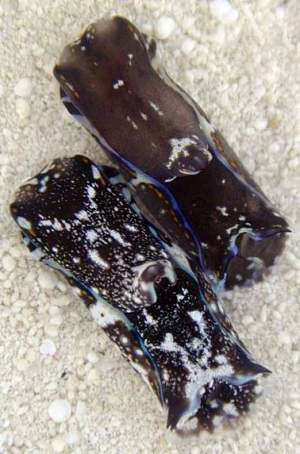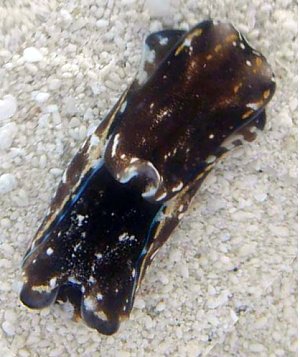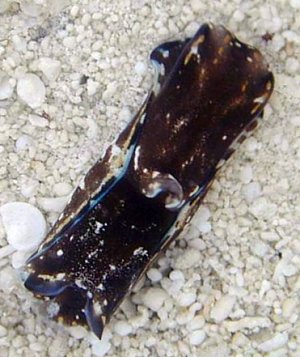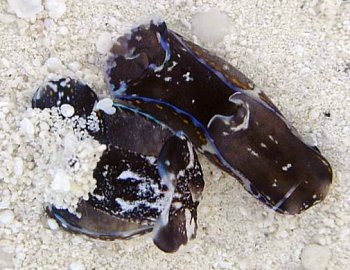Aglaja depicta? from the Caribbean
April 9, 2003
From: Anne DuPont

Hi Bill,
How are you and things at the museum? I need your help once again to identify a nudibranch I found in the Bahamas this winter.
Here is a little background:
I found them over a range of 100 miles in the Southern Bahamas (The Exumas chain of islands) in depths from 2 feet to 10 feet.
Their size was 1/8 inch to about 1 inch long.
They were crawling on the sand in the day, and when my strobe would fire, they would bury in the sand. They were quite active.
They varied in color from dark brown to medium brown, and brown and white speckled.
These photographs were taken on January 17, 2003, and I saw many on each snorkel dive during January, February and March. And everywhere I found them, there were lots of Chelidonura hirundinina in the same area, sometimes both nudibranchs would be a few feet apart. Is this an Atlantic "Philinopsis cyanea"?
Thank you for your time and the wonderful Forum.
Cordially,
Anne DuPont
Delray Beach, Fl
akdupont@bellsouth.net



Dear Anne,
This is another interesting find. It's a good example of how little we know about even the most abundant animals. Certainly if I found these in the Indo-West Pacific I would immediately identify them as a colour form of P. cyanea, and it may turn out on investigation that they are a Caribbean population of that species. At this stage though I have tried to identify them with a species known from the Atlantic region.
Marcus & Marcus (1967) described Aglaja pusa from a single preserved specimen collected in Key Biscayne, Florida. It was 45mm long preserved, and its preserved colour was described as 'greyish black interrupted by numerous pigment-free spots of various sizes, some oblong, some round with a dark centre. Fusion of these light areas produces local vermiculated designs'. The shape of the penis fits my description (Rudman, 1972) of P. cyanea. The colour of your animals are consistent with Marcus' description of their A. pusa. However if we look at photos of Aglaja depicta from the Mediterranean, I suspect your animals are probably identical. This raises the question I discuss in an earlier message concerning what genus A. depicta really belongs to. If it is really a Philinopsis, then perhaps P. cyanea and A. depicta are one circum-global species. What is sadly lacking is a re-examination of the anatomy of A. depicta. Until we know the detailed anatomy of the reproductive system and the penis it is not possible to determine its generic placement.
In summary, I think this is probably the first record of A. depicta in the Caribbean, I suspect A. pusa is a synonym, and it would be nice to know a little more detail about the reproductive system of A. depicta.
References:
• Marcus, Er. & Marcus, Ev. (1967) American opisthobranch mollusks. Part 1, Tropical American opisthobranchs. Studies Tropical Oceanography, Miami, 6(1-2): 1-137. (Figs 1-150, Pl.1, figs 1-9)
• Rudman, W.B. (1972) A comparative study of the genus Philinopsis Pease, 1860. (Aglajidae, Opisthobranchia). Pacific Science, 26(4): 381-99, 15 figs, 1 plate.
• Rudman,W.B. (1974) A comparison of Chelidonura, Navanax and Aglaja with other genera of the Aglajidae (Opisthobranchia, Gastropoda). Zoological Journal of the Linnean Society, 54(3): 185-212.
Best wishes,
Bill Rudman
Related messages
-
Philinopsis depicta from the eastern Mediterranean
From: Bogi Cesare, May 14, 2009 -
Philinopsis depicta from the Mediterranean
From: Dominique Horst, May 13, 2009 -
Aglajids from Turkey
From: Tom Turk, November 23, 2007 -
Philinopsis depicta color forms
From: Anne DuPont, August 27, 2005 -
Variation in Philinopsis depicta from Bahamas
From: Marina Poddubetskaia, March 25, 2004 -
Philinopsis depicta eating Aglaja felis
From: Marina Poddubetskaia, March 25, 2004 -
Philinopsis depicta from Turkey
From: Haluk Akbatur, September 29, 2003 -
Philinopsis depicta from Tunisia
From: Anis, May 5, 2003 -
Aglaja depicta or Philinopsis depicta
From: Bill Rudman, April 14, 2003 -
Lunch menu for Aglaja depicta
From: Baki Yokes, June 10, 2002 -
Aglaja depicta from the Mediterranean
From: Erwin Koehler, December 10, 2001
